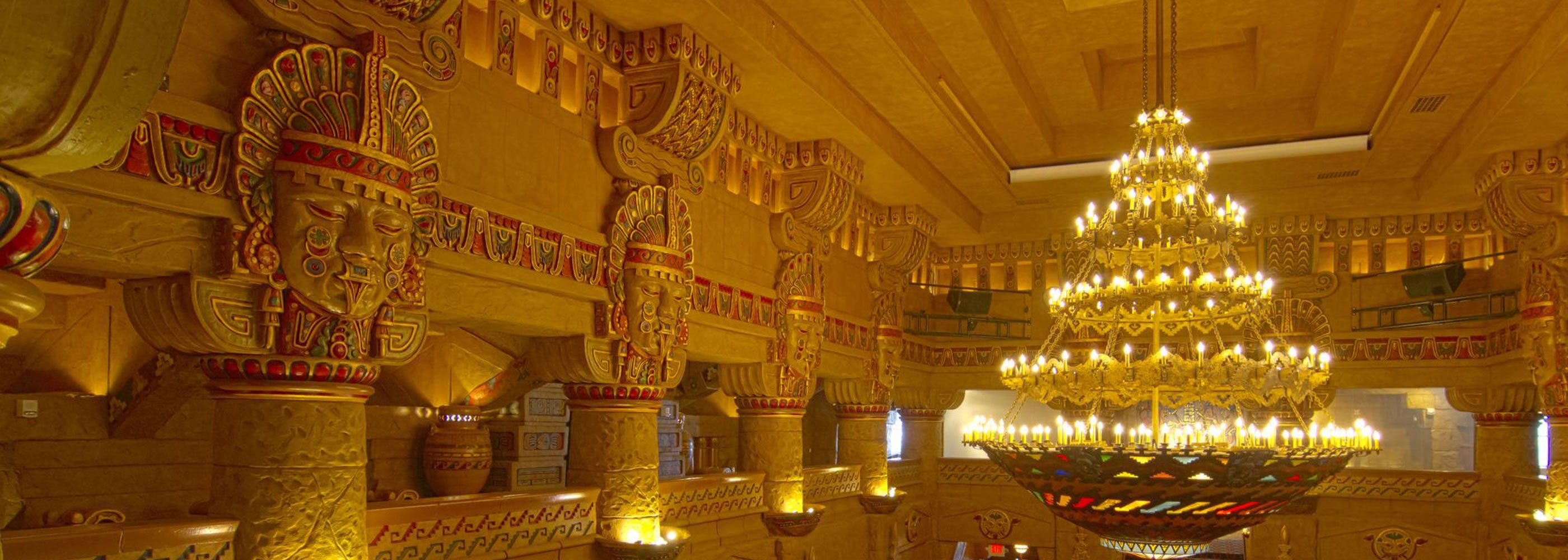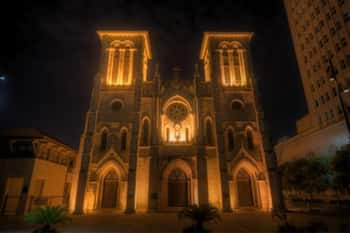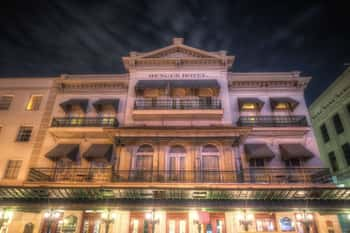
Along with the Majestic and The Empire, the Aztec helps to make up San Antonio's Theatre District. The historic Aztec Theatre was built in the Roaring Twenties (in the year of 1926) and held an astounding capacity of 1,500 seats. The theatre has also been well noted for its Gatsby-esque grandeur.
In the year of 2009, like most of the old-school theaters operating in the United States today, the Aztec Theatre became a venue for live entertainment. The theatre's stage has been graced by the blues gods, with performances by Buddy Guy, George Thorogood and Kenny Wayne Sheppard. You can catch just about anything at the Aztec, from pop to rap, and even a few comedians too.
In its many years, the Aztec Theatre's stage has also been rumored to be "graced" by spirits and haunted by overworked projection operators whose experiences and struggles were the stuff of blues legends.

The Aztec Theatre was designed at the height of the Roaring Twenties, by architects Robert Kelly and R. O. Koenig. The theatre was built within a six story building, and featured a three ton chandelier. The Aztec's grand opening was on June 4th, of 1926. A year later, the theatre showed its first talking picture, Don Juan, starring John Barrymore.
While, the Aztec continued with great success during the twenties, the Great Depression brought forward troubling times. Tension had already been brewing between the the city's movie theatre owners, and the projection operators. The operators formed a union during the twenties, to fight the unfair practices of management, and with the growing economic woes of the thirties, and more hostile working conditions, the upcoming violence was almost inevitable.
On May 4th, in the year of 1932, six people were burned, two quite seriously from an explosion at the Aztec Theatre. The injuries were caused when a sulfur bomb (stench bomb) went off on the lower level of the theatre. The firefighters stationed at the building, responded to the bombing quickly, and the moviegoers exited the theatre without issue.
Warren Dunn (nineteen years old) and C. R. Green (twenty-five years old), suffered first degree burns on their hands and faces, when the duo tried to put out the blaze that was caused by the bomb. Mr. and Mrs. Ivar Hyvari were seated when the bomb went off, resulting in them receiving burns on their legs. S.J. Rosenfield and Miss Billie Henderson, also were burned on their hands and feet.
Rosenfield spoke to the police, telling the officers that he witnessed a young man toss something onto the floor, then kick it to the front of the theatre, right before the bomb exploded. Rosenfield said that he attempted to capture the youth, but was unable to hold on to him once the bomb exploded, and the sulfur began to expel. Rosenfield went on to explain that the sulfur had splatter on him, and the young man was able to escape during the confusion.
The explosion marked the fourth stench bombing to occur at a theatre in San Antonio. Prior to the May 4th bombing at the Aztec, thirty operators (projectionists) went on strike demanding the theatres hire extra hands. The theatres decided instead to fire the thirty workers on April 18th, and hired nonunion and less-trained people from out of town (sort of like Teach for America).
No one was ever arrested for the theatre bombings is San Antonio. Though there was speculation the sulfur bombs "stench bombs" may have been a tactic by the operators who were obviously disgruntled.
San Antonio wasn't the only city that was dealing with this phenomenon, created by the woes of the Great Depression. The union operators of the era, were fighting back against management, but traditional picketing did not work as the managers were always quick and successful in filing court injunctions against the workers.
Some workers, now desperate, turned to threats. Sometimes, handbills would begin to circulate in a city, warning moviegoers if they attend their local theatre, they do so at their own risk. Threats in some cities, escalated to violence. In Columbus, Ohio, in the year of 1931, a gunman who claimed to represent the local projectionists' union, kidnapped a man who owned a chain of theatres in the area, in an attempt to "persuade" him into settling the ongoing labor dispute.
The most commonly used tactic by the operators were their use of stench bombs. Most of these campaigns were carried on without the union's knowledge, usually just a couple of renegades, desperate to resolve the situation. These bombings occurred throughout the country in New York, Iowa, Missouri, Oklahoma, Ohio and Minnesota.
In the 1930s most operators had to fight just to keep their current salary, although most were forced to take pay-cuts, rather than being laid off. Also, safety precautions suggest two operators should be employed to operate the new and more difficult talking picture projectors. The new technology had actually been proven to be too dangerous for just one person to operate on their own, and some publications went as far to say, it was "inhumane." Congress even made efforts to pass legislation to require theatres to hire two operators, but the attempt failed due to special interest (the rich and privileged).
The management and owners of most of the theatres in the country remained unconvinced of the operators' plight (these are the grandparents of those who do not believe in global warming). These Henry F. Potters of the world, stood their ground, an amazing feat considering they didn't have a leg to stand on (pun intended).
The sides became so contentious, that violence was written on the wall. Good men, became bitter, and angry men were driven mad. Driven so mad, that they became extremists. And, this set the stage (pun not intended) for a violent era in movie theatre history.
In January of 1932, two stench bombs were set off at two different movie theatres in Milwaukee, the event repeated just a few months later. In 1933, Memphis faced their own stench bombing campaign. The city's three most popular theatres, The Princess, The Memphis and the Linden Circle Theatres were all bombed. Also, all three of the theatres just so happened to be owned by M.A. Lightman, who had fired the unionized operators just before the bombings took place.
These were by no means regional acts, in 1931, Dallas was victimized by five stench bombs in the span of just one week. But, Los Angeles, Hollywoodland, might have the record, Los Angeles District Attorney's office reported that in a period stretching over six weeks, there were over fifty stench bombings that occurred at movie theatres located within the city alone.
Stench bombings were designed to hurt the management and the owners. After an attack, refunds were demanded by patrons, and theatres usually were forced to close for weeks, if not longer, thus costing the theatre owners lots and lots of moolah, dead presidents, Benjamins, cabbage, aka money. As they say, "cash is king." And, just one of these bombs could cause a theatre to lose 4,000 dollars, roughly the equivalent of 70,000 dollars today. So, it's easy to see why this was the goal, the reasoning behind the stench bombing campaigns.
Moreover, the odor admitted from the stench bombs were so significant that floors had to be ripped up, and curtains and artwork were ruined, either by the flames from the blast or the lasting smell. In some cases, years after the bomb's explosion, the stench was still pungent, emanating from the walls like a two-week-old Easter egg that was never found and left to rot behind a tree for eternity.
These stench bombs did more than just leave theatres all kinds of stinky, they caused physical damage to the properties as well. But, shattered windows and broken radiators seem rather trivial in comparison to the lives of the people who were put in jeopardy by these overzealous and vengeful attacks.
In San Antonio, the owners of the theatres may have been hit in the wallet by the stench bomb attacks, but the moviegoers suffered physical injuries. In 1930, San Antonio's Uptown Theatre, was bombed early one morning while closed. Its lobby was damaged, but no people were harmed. However, a year later, the Uptown was bombed again, and this time it was during a screening, on a busy Saturday night. Amidst the blast, glass ended up shattering, and badly injured a woman seated in the audience.
In the ensuing months, there were more brazen stench bombings in San Antonio, these also occurred during the theatres' hours of operation. These acts were not helping the projectionists' cause in the public eye, as these attack usually lead to mass injuries. At another theatre, an unseen man threw a stench bomb from the balcony, seriously burning three people, including a young teenage girl. Another person in the audience passed out from the powerful smell of the stench bomb.
As, I had previously mentioned in May of 1932, the Aztec Theatre was also bombed, leading six moviegoers to suffer serious burns, two of whom were rushed to the hospital in critical condition. There was initial confusion of who the culprit might have actually been, possibly just a troubled youth? But, suspicion soon turned to the operators, who had been fired the previous month after going on strike.
Nothing was accomplished by these attacks, non-union workers were hired, and people's lives were put in danger. But, these are the kind of crimes that happen when the Scrooges of the world go unchecked, they'll squeeze the Cratchits of society so tightly, that their minds become warped, leading them to commit such awful misguided acts.
Like most of the other picture houses in country, the Aztec Theatre hit a wall in the 70s, showing cheaply made B Movies. There was a last minute attempt to save the Aztec by chopping it up into three auditoriums, and thus it became known as the Aztec Triplex. But, this did little to actually revive The Aztec, and the theatre closed its doors in 1989.
In 1992, The Aztec was on life support, and was about to be demolished in order to make way for a parking garage. To keep the theatre from being crushed like a soda can, the Aztec was put on the National Register of Historic Places.
Years later, with the growing popularity of San Antonio's Riverwalk, the Aztec Theatre reopened in August of 2009, but not for motion pictures. No, this time around, the theatre became a venue for live music.
With the passing of a few more years (in 2013), PHH Entertainment Ventures LLC, knowing a good thing when they see it, signed a long-term lease, with the goal of turning the Aztec into the ultimate venue for concert goers. However, their goal was short lived, in 2015 a majority percentage (51%) of the Aztec was sold to Beverly Hills based company, Live Nation International (the people behind the House of Blues). The Aztec, luckily, will not become another House of Blues, it will retain its historical name.
"This is a good match," said Sam Panchevre, the Executive Director of the Aztec Family Group (who owns the building which houses the Aztec Theatre). Panchevre, elaborated about the new deal "Live Nation brings the equity and experience to continue growing the Aztec Theatre into a national live music and special event venue” He went on to add, “This agreement with Live Nation will enhance the concert goers experience at the Aztec Theatre, while launching San Antonio as a competitive music market.”
Ben Weeden, the Chief Operations Officer for House of Blues, commented about the purchasing of the Aztec Theatre, stating that it “was the next logical move for us in Texas.” He also, spoke glowingly about San Antonio, saying it is a “vibrant music market with a very large population base that we think is underserved at the club and theater level.”
No matter the owner of the Aztec Theatre, or whether it operates as a movie house or a venue for live performances, the theatre has proven it is a survivor and will continue to be a source of entertainment for the people of San Antonio.

Over the years, the theatre has changed hands many times, some say the theatre is cursed, with the hauntings driving each owner nearly insane, forcing them to sell the Aztec, while they are still of mind. Could this curse or hauntings be the work of ghostly projection operators? Unable to get some sort of justice while alive, do their souls now haunt the Aztec, determined to drive anyone who owns the theatre into madness? This is the ultimate revenge after all.
One of the spirits that have been sighted at the Aztec Theatre, is a phantom operator located in the projection booth. In the past, the spirit in the booth, would play tricks on whomever was operating the projector. Perhaps, hazing the new guy, or maybe the spirit is trying to scare off any non-union operators.
Since, the recent renovations at the Aztec, the sightings have diminished. Has the curse been lifted since the theatre is no longer a movie house? Hopefully, the spirits are at peace, and enjoying the live performances that now go on at the Aztec.
You can find the Aztec Theatre right in the heart of downtown San Antonio. It's located just off of West Commerce Street at 104 North Saint Mary's Street. The Aztec is now considered to be the concert gem of San Antonio, and is the perfect place to catch your favorite band or comedian when they come into town.

San Antonio's most haunted Church

San Antonio's most haunted Hotel

San Antonio's most famous haunted landmark